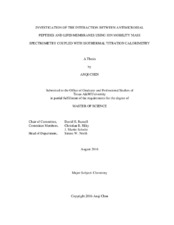| dc.description.abstract | Antimicrobial peptides (AMP) are involved in many biological processes owing to their ability to interact with the cell membranes. The aim of many biophysical methods is to understand the mechanism of AMP function such that their bioactivities can be tailored for therapeutic purposes. There is no single experimental technique that can provide a complete understanding of the mechanism of AMP-bilayer interactions; however, this emphasizes the necessity for a combination of techniques in order to provide a more complete view of cellular processes. In this study, ion mobility mass spectrometry (IM-MS) is coupled with isothermal titration calorimetry (ITC) to study the interaction between antimicrobial peptide gramicidin A (GA) with lipid bilayer as well as between antimicrobial peptide gramicidin S (GS) with lipid bilayer. IM-MS can probe the membrane bound structure of GA and the conformer preferences of GA can be influenced by the physical properties of lipid comprising the bilayer. The information obtained from IM-MS is limited to investigation into structural changes of the peptide and the effects of the peptide on surrounding lipids remain to be resolved. Here, ITC is used as a complementary technique to elucidate the lipid-peptide interactions. ITC is capable of providing a thermodynamic description of the entire binding process of GS to various lipid bilayer model membranes. The thermodynamics of the binding of GS can be affected by the properties of the bilayer, thus it is possible to incorporate small molecules that affect the bilayer physiochemical properties, such as cholesterol, or peptide like GA into the bilayer and study how the presence of these molecules affects the thermodynamics of GS binding. Also, since the conformer preferences of GA in membrane is sensitive to the lipid structure and composition, and the conformational changes of GA can be probed by IM-MS, it is also possible to use GA as a “reporter” to investigate how binding of GS changes the lipid environment. The mechanism of GA and GS interaction with lipid bilayer can thus be elucidated through combining the information obtained from ITC with that from IM-MS. | en |


